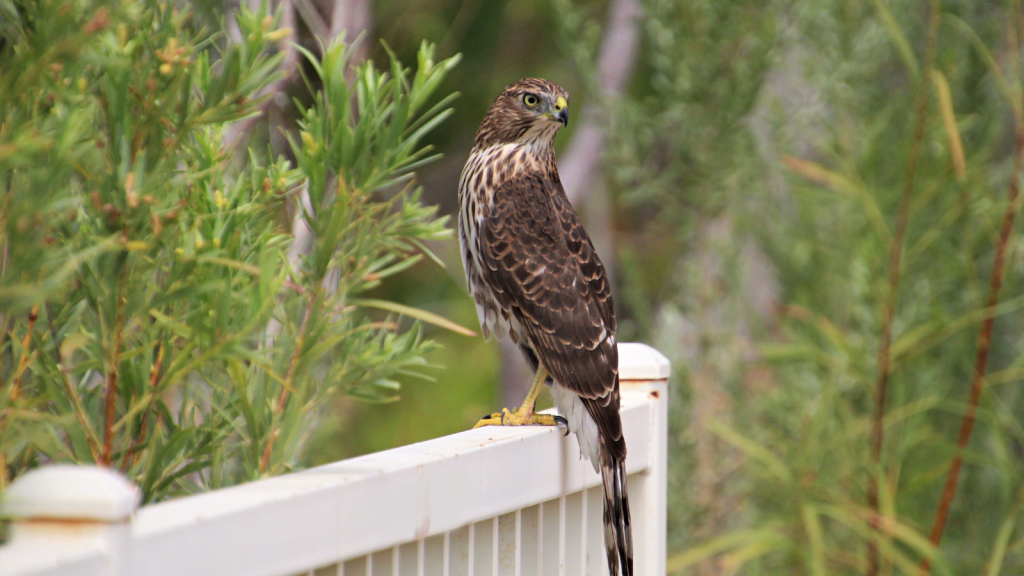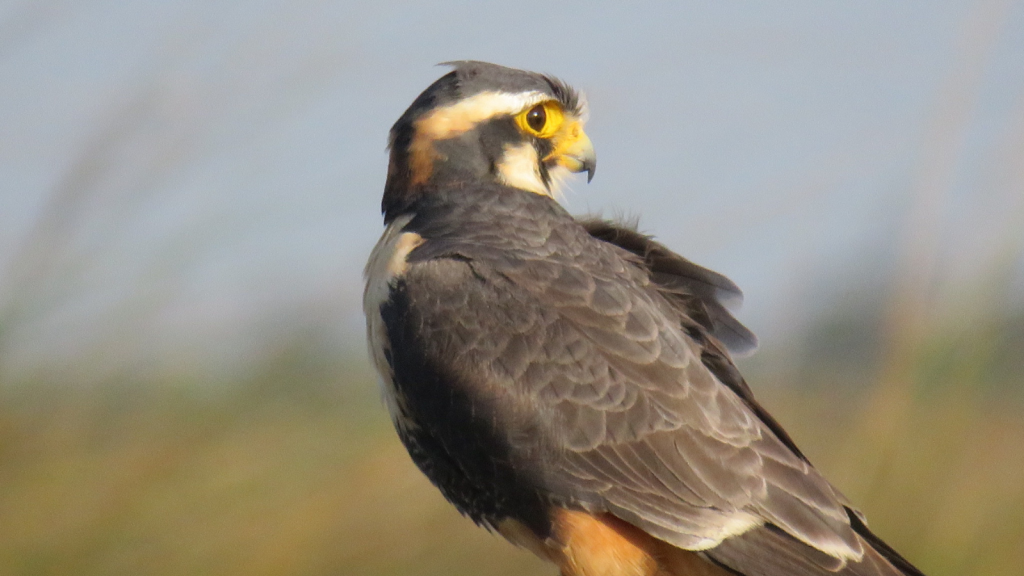The skies above us are not always as peaceful as they might seem. While many birds soar gracefully through the air, some are on the hunt for their next meal – and that meal might be another bird. These aerial predators are masters of the sky, using their speed, agility, and keen eyesight to catch their feathered prey mid-flight. From the lightning-fast peregrine falcon to the powerful golden eagle, these birds have evolved remarkable hunting skills. Their aerial attacks are both terrifying and awe-inspiring, showcasing nature’s raw power and the ongoing struggle for survival in the wild.
Peregrine Falcon

The peregrine falcon is renowned for its incredible speed, reaching over 200 mph during its hunting dives. These sleek birds of prey target a wide range of other birds, from small songbirds to larger waterfowl. Their razor-sharp talons and hooked beaks make quick work of their unfortunate victims, often catching them completely off guard in mid-air. Peregrines have excellent eyesight, able to spot potential prey from over a mile away.
Golden Eagle

With its massive wingspan and powerful build, the golden eagle is a formidable hunter of the skies. These majestic birds can take down prey as large as cranes and geese, using their strength to overpower their targets. Golden eagles are known to hunt in pairs, working together to bring down larger birds in flight. Their hunting success rate is impressive, with some studies showing they catch their prey in up to 20% of their attempts.
Gyrfalcon

The gyrfalcon, the largest of the falcon species, is a skilled hunter of other birds in the Arctic regions. These powerful raptors are known to pursue and catch birds as large as geese and gulls in mid-air. Their white plumage helps them blend in with the snowy landscape, giving them an extra edge in their aerial hunts. Gyrfalcons have been observed flying at speeds of up to 130 mph when chasing prey.
Eurasian Sparrowhawk

A common sight in gardens and woodlands, the Eurasian sparrowhawk is a nimble hunter of smaller birds. These agile raptors use their short wings and long tail to manoeuvre through tight spaces, often surprising their prey with sudden, explosive attacks. They’re known to catch birds as varied as finches, thrushes, and even pigeons in flight. Female sparrowhawks are significantly larger than males, allowing them to target a wider range of prey species.
Northern Goshawk

The northern goshawk is a fierce predator of the forest, capable of taking down birds much larger than itself. These powerful hawks use their broad wings and long tail to navigate through dense woodlands, often catching their prey by surprise. They’re known to hunt wood pigeons, pheasants, and even other raptors in mid-air. Goshawks have exceptional eyesight, with vision up to eight times sharper than human eyesight.
Merlin

Despite its small size, the merlin is a fearsome predator of other birds. These compact falcons are incredibly agile, able to chase down fast-flying birds like swallows and martins in aerial pursuits. Merlins often work in pairs, with one bird flushing out prey while the other makes the kill. They can reach speeds of up to 40 mph during level flight, but can dive much faster when attacking prey.
Hobby

The hobby is a summer visitor to Britain, known for its incredible aerial acrobatics. These sleek falcons specialise in catching swifts and swallows – some of the fastest and most agile birds in the sky. Hobbies can even catch and eat their prey while still in flight, showcasing their remarkable mid-air skills. Their diet also includes large insects like dragonflies, which they catch and eat on the wing.
Red Kite

Once nearly extinct in the UK, the red kite has made a remarkable comeback. While they’re known for scavenging, these graceful raptors are also capable of catching smaller birds in flight. Their forked tail gives them excellent manoeuvrability, allowing them to snatch birds out of the air with their sharp talons. Red kites are also known to steal prey from other birds of prey, a behaviour known as kleptoparasitism.
Lanner Falcon

The lanner falcon is a versatile hunter, known for its ability to catch a wide variety of birds in flight. These falcons are particularly adept at hunting in groups, working together to bring down larger prey like pigeons and ducks. Their cooperative hunting behaviour makes them formidable aerial predators. Lanner falcons can reach speeds of up to 180 mph during their hunting stoops.
Saker Falcon

The saker falcon is a powerful bird of prey, known for its strength and endurance in flight. These falcons are capable of taking down large birds like cranes and bustards in mid-air. Saker falcons have been prized for centuries in falconry for their hunting prowess and adaptability. They have a unique hunting technique where they fly low and fast, using the element of surprise to catch their prey off guard.
Cooper’s Hawk

The Cooper’s hawk is a skilled hunter of other birds, particularly adept at chasing prey through woodland areas. These agile raptors use their long tails and short, rounded wings to navigate through trees at high speeds. They’re known to catch a variety of birds, from small songbirds to larger pigeons and doves. Cooper’s hawks have been observed using buildings and other structures in urban areas as hunting perches, adapting well to city life.
Hen Harrier

The hen harrier is a ground-nesting raptor that hunts other birds both in flight and on the ground. These graceful hunters use their keen eyesight and hearing to locate prey, often flying low over fields and moorlands. Hen harriers are known to catch a variety of birds, from small pipits to larger grouse and waders. Male and female hen harriers have different hunting strategies, with males typically catching smaller prey and females tackling larger birds.
Aplomado Falcon

The aplomado falcon is a sleek, agile hunter known for its cooperative hunting behaviour. These falcons often hunt in pairs, working together to pursue and catch other birds in flight. Their speed and teamwork make them effective predators of a wide range of bird species, from small songbirds to larger doves and quail. Aplomado falcons are also known to chase birds into vegetation, where their mates are waiting to ambush the flushed prey.
Eleonora’s Falcon

Eleonora’s falcon is a specialised hunter of migrating birds. These falcons time their breeding season to coincide with the autumn bird migration, taking advantage of the abundance of exhausted travellers. They’re known for their acrobatic aerial pursuits, often catching small birds like swallows and warblers in mid-flight. Eleonora’s falcons have been observed hunting at night, using moonlight to catch nocturnal migrating birds.
Great Black-Backed Gull

While not typically thought of as a bird of prey, the great black-backed gull is a formidable hunter of other birds. These large, powerful gulls are known to attack and kill birds as large as puffins and small ducks in flight. They use their size and strength to overwhelm their prey, often working in groups to bring down larger birds. Great black-backed gulls have also been observed following fishing boats, snatching smaller seabirds that are attracted to the boat’s discards.
\
10 Desert Predators With Unique Hunting Adaptations

The harsh desert environment has shaped some of the most remarkable hunters on Earth. These animals have evolved incredible ways to survive and thrive in a world of extreme heat and scarcity. From silent stalkers to venomous ambush experts, desert predators are masters of adaptation. Their hunting techniques are as varied as they are fascinating, each perfectly suited to the challenges of their arid homes. Join us as we explore ten of these amazing creatures and the special tricks they use to catch their prey.
Read More: 10 Desert Predators With Unique Hunting Adaptations
15 Facts About the Honey Badger, the Fiercest Animal in Africa

The honey badger, a small but mighty creature, roams the African wilderness with a fearless attitude that’s earned it quite a reputation. These tenacious animals have captured the imagination of wildlife enthusiasts and casual observers alike. Despite their name, honey badgers aren’t closely related to European badgers and are more akin to weasels and otters. Their tough-as-nails approach to life and remarkable abilities have made them the stuff of legend. Let’s explore some fascinating facts about these extraordinary creatures that prove why they’re considered Africa’s fiercest animals.
Read More: 15 Facts About the Honey Badger, the Fiercest Animal in Africa
Becky is a fervent wildlife enthusiast and pet care expert with a diploma in canine nutrition. Her love for animals stretches beyond the domestic, embracing the wild tapestry of global fauna. With over a decade of experience in animal welfare, Becky lends her expertise to OutlandishOwl through insightful articles, captivating wildlife information, and invaluable guidance on pet nutrition. Her work embodies a deep commitment to understanding the intricate lives of animals and a passion for educating others on sustaining natural habitats. Becky's hands-on conservation efforts and her knack for translating complex dietary science into practical pet feeding tips make her an indispensable voice for creatures great and small.




